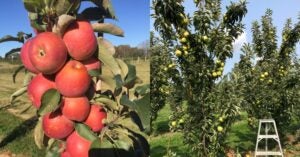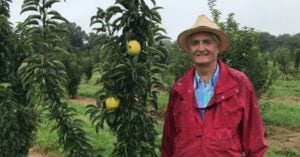Through careful crossbreeding and selection, University of Maryland researchers have developed what they’re saying may be the perfect apples for American growers trying to adapt to a changing world. The only catch — they’re bred for direct consumer sales, so you won’t see them on supermarket shelves anytime soon.
The two new apples — a yellow and a red one — are heat-tolerant, blight-tolerant, low-maintenance, easy to harvest, and not least, delicious. Both have been approved for patents and are awaiting the final grant from the U.S. Patent Office.

They address a growing suite of problems the apple industry has been grappling with. The fruit has always been labor-intensive to bring to market, with trees that need to be trained, pruned, and harvested by hand.
In the past decade, all U.S. farmers have felt the squeeze of labor shortages, and the apple industry has been among the hardest hit. According to USApple, the nonprofit apple industry association, labor shortages caused an average 3 percent drop in U.S. crop production employment annually from 2016 to 2021, but apple orchard employment plummeted by 22 percent a year. Meanwhile, the wages farmers must pay have risen at the same time the price of fresh apples has fallen.
Compounding these stressors on apple growers, the climate is changing rapidly: Heat waves in the Pacific Northwest in recent years strained the country’s largest apple producing areas. The South is growing hotter, and northern and eastern regions of the country are seeing shorter and warmer cool seasons, all of which spell uncertainty for orchard fruits tuned to cooler conditions.
The UMD team’s new apple trees could help farmers sidestep these obstacles.
What makes these apple trees special
“These trees require a lot less hand labor compared to apples that are available to growers now,“ said Chris Walsh, University of Maryland professor emeritus in the Department of Plant Science & Landscape Architecture who developed the new apples with his colleagues Julia Harshman and Kathleen Hunt. “We can’t say they’re non-pruning, but the pruning a farmer would do is minimal on these trees.”

The new Maryland varieties grow into much shorter trees, which makes harvesting easier; they also appear tolerant to fire blight, a destructive bacterial disease common to apples. Heat tolerance is another important feature of these apples. It’s one of the earliest characteristics Walsh and his team bred into apples, and was a feature they introduced with the Antietam Blush apple in 2017. Specifically designed to grow in Maryland’s warm, humid climate, the Antietam Blush was the first University of Maryland apple released.
It was the product of the Tree Architecture Program that Walsh launched more than 30 years ago with the planting of some 5,000 apple seedling trees from eight different commercial varieties at the Western Maryland Research and Education Center in Keedysville, Md.
Now, the release of a yellow apple called MD-TAP1 (which stands for Maryland Tree Architecture Program), and a red apple called MD-TAP2 stand to extend the program’s success even farther, because these apples feature a full suite of characteristics that make life easier for growers across the country.
Michigan State University and Texas A&M University scientists will be conducting trials to see how well the apples grow in their climate conditions.
Getting MD-TAP1 and MD-TAP2 to consumers
The next step will be to license the apples to a commercial nursery that will produce the stock in large numbers and sell trees directly to apple growers. That nursery would most likely have the honor of coming up with a snazzy marketable name to replace MD-TAP1 and MD-TAP2.
When these apples make it to market, consumers are likely to see them in local fruit stands and farmer’s markets as well as pick-your-own farms.
The yellow MD-TAP1 comes from a parent stock of apple marketed as GoldRush, and it looks and tastes a bit like a Golden Delicious. Its fruit ripens in late September. The red MD-TAP2 is a child of Fuji apple stock, so it carries many of the same sweet flavor attributes. It ripens in October which is perfect timing for the pick-your-own apple and pumpkin season.


